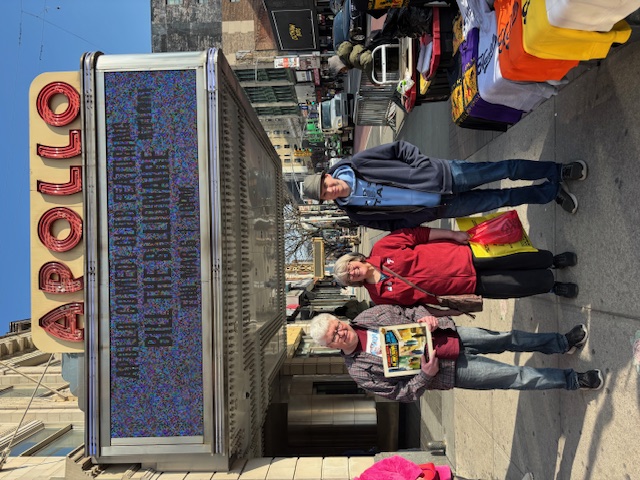
Introducing: The IHTOV Zine
Published on Dec 15, 2025
Christmas Music Selections
Published on Dec 14, 2025
The Beastie Boys and Me
Published on Dec 10, 2025
The Doors and Me
Published on Dec 8, 2025
More Liner Notes…
Featured Essay: Back to the Mother House
by Rich Wilhelm

Few albums evoke a sense of place quite like the 1963 release, Live at the Apollo, by James Brown and the Famous Flames. Or as Fats Gonder introduces him at the top of the album:
National and International known as
the hardest working man in show business!
Man that sang “I Go Crazy”!
“Try Me”!
“You’ve Got the Power”!
“Think”!
“If You Want Me”’!
“I Don’t Mind”!
“Bewildered”!
Million-seller “Lost Someone”!
The very latest release, “Night Train”!
It’s everybody “Shout and Shimmy”!
Mr. Dynamite, the amazing Mr. Please Please himself, the star of the show James Brown and The Famous Flames!
Yeah, that James Brown. And that would be the Apollo Theater on 125th Street in Harlem, New York City. Perhaps the greatest monument to Black music in the United States, if not the world.
Entire books have been written about Live at the Apollo but in the spirit of the album itself (just over 30 minutes long), I will keep the history brief. Brown was already known and beloved throughout Black America in 1962 but hadn’t quite broken through on the pop charts. He decided to record his midnight show at the Apollo on October 24, 1962 and release it as a live album.
His record company said no, we’re not going to do that. Brown prevailed and the album was a huge smash, ushering in James Brown’s many triumphs to follow.
These days Live at the Apollo is often considered to be the greatest live album ever, and for good reason. Live at the Apollo is, even today, an intensely visceral experience, with every single attendant in that very lucky crowd making themselves heard.
I own a nice stack of vintage James Brown vinyl and maybe I’ll write about how cool they are some other time. But for years, I had to settle for a CD version of Live at the Apollo. Then one day browsing through the bargain bins at a local shop, I found it.
James Brown. Live at the Apollo. Ten bucks.
You might think $10 is pricey for an album in the cheap racks, but make no mistake:
An original 1963 pressing-as far as I know, and I have no reason to doubt it-of Live at the Apollo for ten bucks is my greatest bargain bin find ever. I snatched that record up and hurried to the cashier.
I wasn’t expecting the record to be pristine-James Brown records from the ‘60s rarely are-but when I got home and played the record, I was ecstatic to discover it played straight through, Gonder’s introduction all the way through the loungey send-off that follows “Night Train” without a single skip.
Again: this Live at the Apollo is my greatest bargain bin find. Ever.
As is the case with every used record I’ve acquired, my Live at the Apollo has a secret history of past owner(s) that I will never know. The cover is taped at the top and bottom but otherwise is in good shape.
As I mentioned, the vinyl is generally in great shape, which makes me wonder how often this treasure was played. Or maybe it was just very well taken care of.
My copy of Live at the Apollo has its own personal history, which I enhanced this week when I returned the record to the source of its creation, the mother house itself, the Apollo Theater.
We had started our afternoon at the Cloisters, a museum that I love. High above the Hudson River, the Cloisters (a branch of the Metropolitan Museum of Art) is filled with medieval art, much of it religious. Regardless of one’s spiritual bent, visiting the Cloisters can be an ethereal and haunting experience.
After our visit, we drove the 4.6 miles to Harlem, for a religious experience of a whole different kind.

I have been on 125th Street twice before, just to see the Apollo from my car. But this time, Donna, Chris and I walked up 125th from Park Avenue, the famous marquee becoming more prominent with every block. Once we reached the Apollo, we entered the lobby/gift shop, talked to the cashier and her friend (who told us his dad had appeared at the Apollo with his group, the Solitaires), stared longingly at the doors that would have taken us into the theater itself (we couldn’t do a tour, but hopefully someday we will), and soaked up the vibes as best we could.
After taking the necessary photos in front of the Apollo, we grabbed something to eat and then made one more stop, at the nearby Marcus Garvey Park, site of the 1969 concert series brilliantly resurrected by Questlove in his Academy Award-winning documentary film, Summer of Soul.
We will hopefully return to the area sometime soon, to tour the Apollo and to hit up Ulysses S. Grant’s nearby tomb, which was closed (Donna and I have been there; Chris has not). But in the meantime, we headed home happy to have had an extraordinarily soulful afternoon. Because soul—in many senses of the word–is where you find it and we found it in the Washington Heights and Harlem neighborhoods in New York City.
Rich Wilhelm is a writer and record collector who lives in Royersford, Pennsylvania. Rich is the news editor for the communications department at ASTM International. He has written extensively for Cool and Strange Music Magazine, PopMatters, and his own website, [The Dichotomy of the Dog](https://dichotomy-of-the-dog.beehiiv.com/?_gl=1iyco31*_gcl_awR0NMLjE3NDA2OTAzODIuRUFJYUlRb2JDaE1JM09ici11RGtpd01WV1MzVUFSMkhRaVRZRUFBWUFTQUFFZ0lYVmZEX0J3RQ.._gcl_auMTAzMDk3MDY2NC4xNzQwNjkwMzgw_gaNzQ4MzYxMjAxLjE3NDA2OTAzODA._ga_E6Y4WLQ2ECMTc0MDgyMDYxNy4yLjEuMTc0MDgyMzI1NC42MC4xLjEwOTc5ODYyNDU.). Rich is also a certified volunteer tour guide at Laurel Hill Cemetery in Philadelphia, Pennsylvania. Rich can be found on social media at Bluesky (@rfwilhelm.bsky.social).

